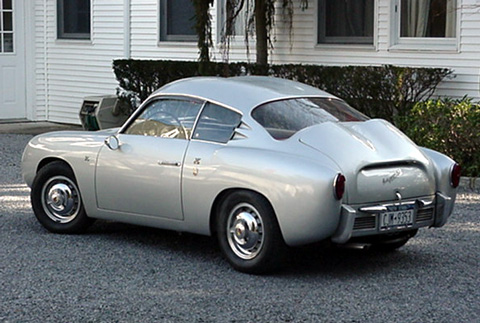
Today the subject of this article resides in a collection in New York.
The story of a particular Zagato in America
Story and Photos by Pete Vack unless otherwise noted
The name sounded odd–Fiat Derivazione Abarth 750 GT Zagato–and did not easily roll off American tongues. But once seen, the car was not easily forgotten, while the long, strange name was quickly replaced by the nickname “Double Bubble”. Not only did it refer to the unique top, but Dubble Bubble is also the name of the original chewing bubble gum, which was very popular at the time, that being 1958-59.
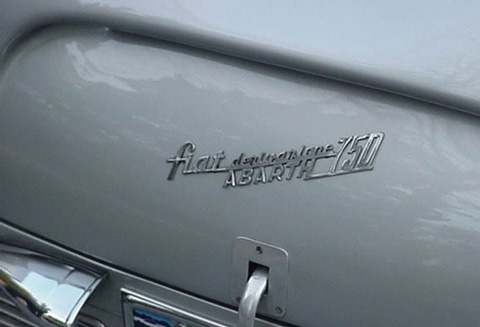
Like “gullwing” for the 300SL, the nickname stuck. As an arm’s length Fiat product, the little Abarths could be ordered via a growing network of dealers. Recognition was also enhanced by an advertising campaign afforded by the East Coast Distributor, Franklin D. Roosevelt Jr., and racing success on both coasts.
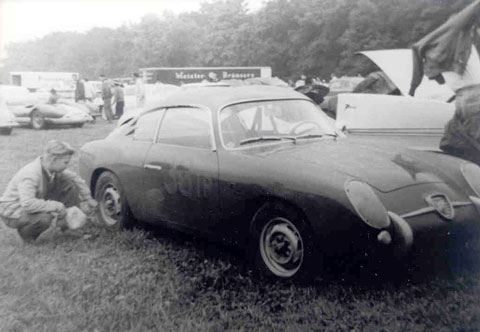
The author in 1960, pondering an Abarth with body by Zagato. Same car as below? We’ll never know. Photo by Donald Vack
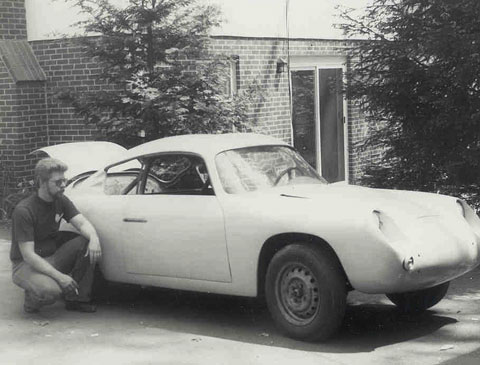
A quarter of a century later, 100*446004 arrives at the Vack household. Ok, we said, NOW what? Photo by Mary Decker Vack
This is the story of one such Double Bubble. Serial number–really Fiat chassis number– 100*446004, originally built in mid 1958 as a series III coupe, was rescued in the 1970s from certain death by a young Viet Nam veteran who had recently returned from that war in far worse shape than which he had left. He found a restoration project great therapy, and proceeded to repair the rust and rot so typical with these long neglected old cars.
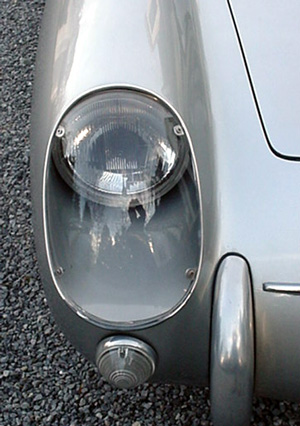
Fragile headlight cover trim was saved by
the Viet Nam vet and still fit the opening.
No two were the same.
Though his name is now forgotten, the recovering ‘Nam vet did a wonderful job, welding in new chassis sheet metal and making the once dented body smooth again. Even more important, he carefully saved almost all of the important and extremely fragile bits and pieces from the body and interior. Still not finished, the car passed to an Abarth enthusiast in the Atlanta area, Mike Blumberg. Mike had other Abarths in the fire an eventually sold it, the restoration still not completed, to me, sometime in 1985. Not quite a basket case, the light blue Abarth was running with a 600D engine, and running very well, noisy with a straight exhaust. However, the interior was in boxes, incomplete, and a complete mystery. The tires and wheels were from a Fiat 850, necessarily larger because 850 disc brakes had replaced the inefficient drum brakes up front. The glass was intact aside from the front windshield, which I thought might be replaced by Plexiglas. Such was the status as delivered.
______________________________________________________
If you are enjoying this article, why not consider a donation to VeloceToday? Click here for details..it’s easy!
______________________________________________________
We started to collect old Fiat 600 bits, but a real breakthrough came when I found another 750GT Zagato https://velocetoday.com/archives/128 in the woods north of Baltimore. A boy named Bonnie was the owner and soon we were. This second Abarth was totally intact but also totally rusted.
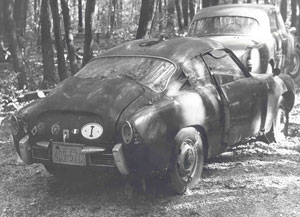
Bonnie’s Abarth. Photo by Mary Decker Vack.
It had a complete, original interior and body trim, which held the key to all the mysterious interior bits and pieces that came with the ex-Blumberg Abarth. In particular, the headliner—intact, original, was in perfect shape. We learned that at least on this Zagato, the leatherette material was stitched lengthwise, and not transversal. In the meantime, we had also learned that although the ex-Blumberg Abarth had a Zagato body number of 1, it did not mean that it was the first Abarth 750GT Zagato, but the first in a series of a particular batch—although how the factory tracked them that way is still beyond this author.
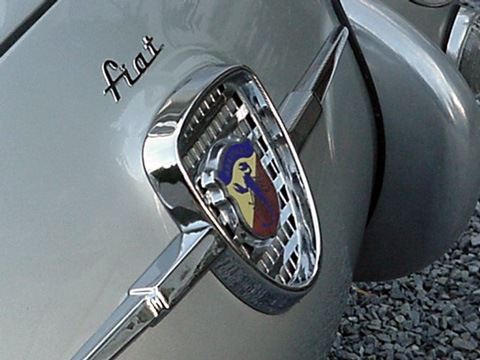
A quirk, perhaps, but the whiskers and grille, and badge of the 750 Zagatos were steel, heavy, and chromed.
Zagato bodies were typical superleggera construction–a steel framework of tubes and supports for doors, tops, inner fenders, etc, was covered by the actual body of sheet aluminum and rolled and screwed to the steel framework. Strips of a cloth-like material were often placed between the steel framework and the aluminum to prevent corrosion. Zagato’s search for reduced weight, however was also evident in the trim and interior of the car.
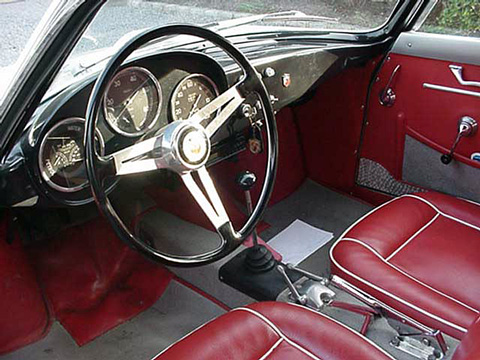
The interior was tiny and large bits of aluminum, wood, many screws, much creative imagination—all made by hand for one car.
The dashboard, windshield trim inside and out, A and B post trim, levers, door trim, and inside door handles were aluminum. Where aluminum parts, including the dashboard and window surrounds had to be mounted to the body, they were screwed to wood supports which were in turn screwed to various points on the steel support structure. Screws were both wood and sheet metal screws. Leatherette and cloth completed the materials. The interior, aside from the instruments and switches, was totally handmade, puzzling, and a masterful display of craftsmanship and brilliant design. We also found that since every single Zagato was hand built, Zagato-made trim items were unique to each body, and rarely if ever could be used in a different car (hence each part was stamped with the body number). For example, the headliner from Bonnie’s car was two inches too short to fit in the blue Abarth. This extended to windshields and windows as well

The lines astound one to this day–how many curves can one fit into a small car and still come out with art?
Over a period of time, the blue Abarth took shape; an original Abarth modified 600 engine along with an Abarth camshaft and muffler were found, and it seemed all the bits and pieces were coming together. The non-standard front discs were replaced by 600 Multipla drum brakes, larger but as drums were still legal for VSCCA eligibility requirements. This seemingly retrograde step was to restore the car to it’s original configuration. I remember arguing in vain with Jerry Greaves, the VSCCA Competition chairman, to try to retain the discs. He said, “If the drum brakes are lousy, drive slower!” An Abarth oil cooler was fitted, and we test drove the car, sans muffler, windshield, tags, etc. on regular occasions until one day a large, very large, sedan with unusually large bumpers followed me around the block. Friendly neighbors had called the local police, complaining about the noisy blue car with no windshield. The officers pulled me over, but muffling guffaws let me go on my noisy way on the promise that I not break the law again.
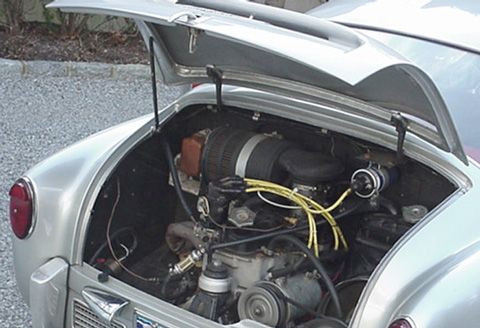
When the local men in blue saw this, they got back into their 7000cc cruiser and left us alone.
After a few years another car was found that demanded much more time and money—and the Abarth Zagato, still unfinished, had to go. It found a home with a collector in New York. I drove it again after the restoration was complete, and found it much like it had been when the police cruiser pulled us over— noisy, revvy, rather slow, extremely light steering, fun in a masochistic way, and delicate, as delicate as the artfully thin plexiglas and aluminum rain guards above the windup windows. But it was far more comfortable now, complete with a windshield, proper seats, license plates, muffler and even a radio. Almost civilized.

Everything was all in one piece, almost everything was original and properly fitted–aside from the twelve inch alumumin rimmed Borranis what were not standard on the U.S. issued 750GT. I can’t even remember where I found them anymore–but I don’t blame the new owner for retaining them, even with the spinner hubcaps which were designed for the standard wheel. No qualms though, and it was very satisfying to see the completion of a 30-odd year restoration and drive the car once again.
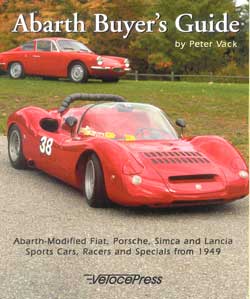
For more information about Roosevelt, Abarths and Zagato, order the “Abarth Buyer’s Guide” by Pete Vack, available now.
Geez Pete, You remind me of the difference between what I do and what a real restorer does — spend endless patience. Pete Egan once told me that if the hobby was just about DRIVING sports cars we’d all own Miatas.
Gorgeous! One of the best looking cars of all time. What I would like to know is the correct pronunciation. I read one article years ago that claimed it was Aw-vart or close to it.
My question is…..how could you ever have parted with this car????
My understanding is that the name is pronounced “ob-art” in German, that which is not art.
In Italia (just got home from Sicilia),it is aah-BARt the ‘h’ is silent.In English we pronounce the ‘h’.Never Arbarth.
Hi, I am at the moment restoring a 1958 Fiat Abarth 750 zagato corsa for a client. He has indicated to me that he wants his car to be the colour of the one in the photographs. Could anybody give me a code or name of the colour?
With regards,
Sacha Rossen.
Peter,
This is very helpful information about the car. I assume it is as close to stage 111 as could be gotten. It almost looks like an original car. I had a corsa back in the late 60’s that I restored and sold to road island. I have some information about my car I would be happy to pass on to you.